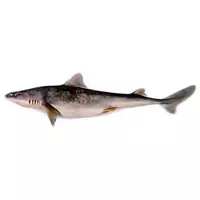Katran shark

The catran shark or Squalus acanthias belongs to the family of sharks of the same name. In addition to the official name of the species, several other different names for katran sharks are found. For example, katran is called nothing more than a marigold, an ordinary spotted or prickly shark, as well as a blunt shark. The main feature of the katran shark can be considered the appearance, as well as the size of the predator.
The catran shark usually lives in the bottom waters occasionally found near the surface of the sea surface. The catran shark swims to the shores in spring, as well as autumn, when the water temperature reaches 15S. It is noteworthy that the catran shark is considered a flock fish that winter together at a depth of 200 meters. The basis of the diet of the katran shark is the fish of such species as hamsa, as well as stavrida.
The katran shark stands out for its small and even miniature size in comparison with other relatives. Often, female katran reach a length of only 100 cm. The katran's range is limited to the waters of the Western and Eastern Atlantic. In addition, the catran shark is common in the waters of the Black and Mediterranean Seas. Like many other shark species, katran stands out for its streamlined body shape, perfect for fish.
The maximum body length of a shark katran reaches 225 cm, and weight - 25 kg. On average, the adult katran reaches a weight of 8-10 kg. It is worth noting that the small size of the shark katran, as well as the elongated structure of the body of the fish, allows you to develop high speeds of movement in the water column. The body of the catran shark is covered with scales, on the fins of the fish there are spines, which can be the only danger to humans.
According to researchers, the catran shark is not dangerous for humans. The katran shark stands out for its distinctive gray color on the sides, as well as the presence of small white spots. As in the case of other more impressive species in the shark katran, the jaw consists of several rows of teeth, with which the fish quickly and carefully grinds food. It is noteworthy that the shark katran grows new teeth in place of those that have fallen out or torn out.
The katran shark is of important commercial importance. Catran shark meat has long been used in cooking and is eaten in various types of heat treatment. As a rule, shark fillet katran or so-smeared shark steak is used in cooking. In addition. Katran shark meat is used to prepare fish balyk, as well as canned food. Not only katran meat is eaten, but also fish oil obtained from fish livers and shark fins.
sharks katran 143 kKal
The energy value of the katran shark (Ratio of proteins, fats, carbohydrates - ju):
Proteins: 19.9 g (~ 80 kCal)
Fats: 7 g (~ 63 kCal)
Carbohydrates: 0 g (~ 0 kCal)
Energy ratio (b | y): 56% | 44% | 0%
 Español
Español Français
Français Português
Português Русский
Русский 简体中文
简体中文 繁體中文
繁體中文 日本語
日本語 한국어
한국어 العربية
العربية Türkçe
Türkçe Қазақ
Қазақ Deutsch
Deutsch Italiano
Italiano Українська
Українська
